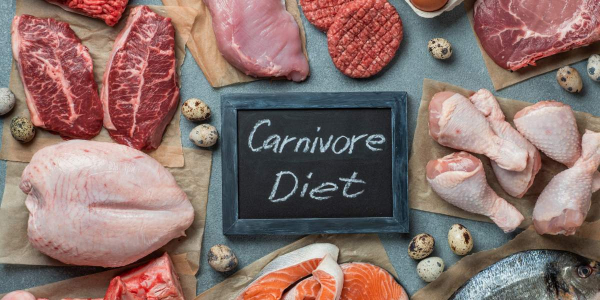
The Fastest Way to Lose Weight AND Keep Your Muscle
The Fastest Way to Lose Weight AND Keep Your Muscle

Ready to supercharge your weight loss journey and achieve remarkable results without sacrificing your hard-earned muscle? It’s time to dive headfirst into the “Protein-Sparing Modified Fast” (PSMF) method!
PSMF is your secret weapon, seamlessly blending the benefits of fasting with muscle preservation. This method is all about turbocharging fat loss. How does it work, you ask? By dialing down those pesky carbs and fats while making sure you get your fill of protein. The result? Improved insulin sensitivity and a one-way ticket to smashing through those stubborn weight loss plateaus!
This article is tailored for individuals who consume animal products, drawing from personal experience and perspective. Having explored SO MANY dietary approaches, including raw veganism, health veganism, and vegetarianism in the past, and ultimately found that these diets did not align with my goals and well-being. The focus here is on the advantages and insights gained from an animal-based nutrition approach.
How I Found Success with the Keto/Carnivore Diet + PSMF
I’ve been on a rollercoaster with my weight since I was 12, and at the age of 46, I’ve seen my fair share of diets come and go. But let me tell you, the ketovore/carnivore diet has been a game-changer like no other. I embarked on this journey on 10 November ’22, and the results have been nothing short of incredible.
When I kicked off my adventure, I was tipping the scales at 78.3 kilograms. Fast forward to today, and I’m thrilled to report that I’ve slimmed down to a lean and mean 62 kilograms. I was well on my way to achieving my goal weight of 55-57 kilograms, but here’s where the plot thickens.
I initially embraced a higher-fat approach, believing it was the key to success. Bulletproof coffees, ketovore mayo creations, fat bombs, and an extra dose of fats became part of my daily routine. Little did I know that this twist in my weight loss journey would throw a wrench into the works, stalling my progress for what felt like an eternity.
But, and here’s the exciting part, my relentless curiosity and unwavering commitment to research led me to crack the code. My journey through this style of eating has changed since 23 October ’23 , and I can’t wait to share my newfound insights and success with you. Stay tuned for the rest of the story!
What is Protein-Sparing Modified Fasting?
Protein-sparing modified fasting (PSMF) is a game-changer in the world of weight loss. Originating in the 1970s as a solution for severe obesity, PSMF offers the benefits of fasting without the downside of muscle loss. In traditional fasting, lean mass dwindles, which is far from ideal. PSMF ensures you not only maintain but also build lean muscle, a critical aspect of lasting health.
Operating on the principles of a ketogenic diet, PSMF minimizes carbohydrate intake, forcing your body to tap into stored fat for energy. By focusing on lean protein and reducing fat intake to a bare minimum, PSMF keeps hormones balanced and supports the absorption of essential fat-soluble vitamins.
The result? Rapid fat loss, enhanced health, and unwavering strength. It’s a no-nonsense approach to achieving your goals.
PSMF: Unlocking Rapid Fat Loss, Preserving Lean Strength
Popular Types of Fasting Used for Weight Loss
Fasting has been in the spotlight, driven by its appeal as a fast-track weight loss method. However, it’s crucial to select the right fasting approach that aligns with your goals while safeguarding your long-term health, as not all fasting methods are created equal.
Before delving into PSMF, let’s explore four other commonly adopted fasting techniques that aim to overcome plateaus and expedite weight loss. We’ll assess the impact of each method on your health and body composition.
1. Fat Fasting
Fat fasting, a method embraced by certain keto communities to overcome weight loss plateaus, involves the consumption of pure fats like butter or oil while avoiding carbs and protein. Advocates believe that because fat intake minimally affects insulin levels, it won’t lead to weight gain, under the assumption that low insulin means no fat storage. However, this notion is flawed as it’s possible for the body to store dietary fat, essential to prevent an overload of triglycerides in the bloodstream. Unfortunately, fat fasting is an ineffective and unhealthy strategy for achieving wellness and weight loss.
Unless you’re exercising sufficiently, all the fat you consume during a fat fast, is directed into storage within your fat cells as it leaves no other destination. This outcome is counterproductive if your objective is fat loss. Although a decrease in weight may register on the scale when muscle mass is lost, this is an undesirable outcome. Muscle is invaluable, and dietary fat alone cannot support muscle growth. The essential building blocks for muscle are amino acids from your diet combined with strength training.
2. Egg Fasting
Egg fasting, a practice still observed in some keto communities to break plateaus and accelerate weight loss, involves consuming only eggs. While eggs are nutritious, we do not recommend egg fasting for a couple of reasons. First, it’s challenging to obtain sufficient protein during an egg fast, which is crucial for muscle maintenance and lean mass.
Second, people tend to grow tired of consuming large quantities of eggs quickly, and this can lead to undereating. Although weight loss may occur, it often results from fatigue of eating eggs, which is unsustainable and may compromise long-term health. Instead, a fasting approach that allows for a variety of protein-rich and nutrient-dense foods, including eggs, is a better choice.
3. Intermittent Fasting
Intermittent fasting is an eating pattern that alternates between periods of fasting (not eating or consuming very few calories) and eating. It doesn’t prescribe specific foods to eat but focuses on when you should eat. The most common forms of intermittent fasting include:
1. Time-Restricted Eating: This method involves limiting your daily eating window to a certain number of hours, typically 8-10, and fasting for the remaining 14-16 hours. For example, you might eat only between 12 PM and 8 PM and fast for the rest of the day.
2. 16/8 Method: A specific type of time-restricted eating where you fast for 16 hours and eat during an 8-hour window. For example, fasting from 8 PM to 12 PM the next day.
3. 5:2 Diet: In this approach, you eat normally for five days of the week and significantly reduce your calorie intake (usually around 500-600 calories) on two non-consecutive fasting days.
4. Alternate-Day Fasting: This method alternates between fasting days, where you eat very few calories or nothing at all, and regular eating days.
5. Eat-Stop-Eat: In this method, you fast for a full 24 hours once or twice a week. For instance, fasting from dinner one day to dinner the next day.
6. The Warrior Diet: This involves fasting for most of the day and eating a large meal in the evening, typically within a 4-hour eating window.
Intermittent fasting can lead to various health benefits, including weight loss, improved insulin sensitivity, better metabolic health, and even potential longevity benefits. It’s essential to choose a fasting method that suits your lifestyle and health goals and consult with a healthcare professional if you have underlying health conditions.
4. Extended Fasting
Extended fasting, which involves abstaining from calories for at least 24-48 hours, is another popular type of fasting promising weight loss. However, this weight loss often includes muscle loss, which is undesirable.
Extended fasting may neglect the importance of what you eat when not fasting, leading to unhealthy food choices post-fast, causing cycles of glucose flooding and depletion, and potential muscle cannibalization.
While extended fasting can induce autophagy and apoptosis, touted as the “fountain of youth,” these processes occur naturally and can be stimulated by exercise and strength training. Research shows that exercise, along with a well-formulated ketogenic/carnivore diet, is more effective for achieving health and fitness goals than long-term fasting.
In essence, extended fasting for weight loss or general health is not recommended, as its drawbacks overshadow minor benefits like autophagy. For weight loss, overall health, or disease prevention, a balanced ketogenic diet and exercise are more practical and sustainable choices.
5. Protein-Sparing Modified Fasting
Protein-sparing modified fasting (PSMF) offers an effective alternative to extended fasting while preserving lean mass. It benefits several groups, including gastric bypass patients, bodybuilders, those with insulin resistance, and individuals seeking weight loss. PSMF involves minimizing carbs and fats while achieving or surpassing protein goals to enhance satiety.
This approach forces the body to utilize stored fat for energy, similar to extended fasting, but with the advantage of maintaining satisfaction and a high thermic effect from protein intake, resulting in the loss of 25 to 30 percent of calories consumed. Furthermore, PSMF provides essential fat and nutrient-dense animal protein.
PSMF is a valuable tool to expedite fat loss or overcome plateaus, typically integrated into a weekly routine, supplemented by regular fat-loss macros and occasional overfeeding days. It’s worth noting that PSMF is not suitable for extremely lean individuals.
Contrary to claims that PSMF is unhealthy, it is essentially a milder version of extended fasting and does not lead to lean mass loss, making it a safer and improved alternative.
6. OMAD : One Meal a Day
OMAD stands for “One Meal a Day.” It’s a type of intermittent fasting where you consume all your daily calories during a single meal, typically within a one-hour eating window, and fast for the remaining 23 hours of the day. OMAD has gained popularity for its potential health benefits and simplicity, making it a convenient choice for those looking to control their weight or improve their health.
Why Does PSFM Work?
The PSMF method is a game-changer for rapid fat loss, utilizing your body’s biology to make shedding those extra pounds quick and effective. Let’s delve into why this approach works so well.
The Thermic Effect of Food (TEF)
Different foods have varying effects on your metabolism. Protein, with a TEF of up to 30%, requires significant energy to digest, whereas fat has a mere 3% TEF. By emphasizing protein and reducing overall calorie intake, you force your body to use stored fat for fuel, leading to substantial fat loss.
Oxidative Priority
Your body processes fuels in a specific order based on storage capacity and current demand. Alcohol comes first because the body can’t store it. Carbs follow, but the body has limited storage capacity for them, and excess is converted to fat. Protein comes next, primarily serving to build and repair lean tissues. Finally, dietary fat is the last priority for use as fuel, as it’s easy to store. By limiting other fuels and prioritizing protein on PSMF, you encourage your body to use stored fat efficiently, making it a powerful tool for fat loss.
Ketone Production
When you consume low carbs and low protein, your body doesn’t have enough oxaloacetate to burn all the fat you eat directly. Consequently, your body bypasses the Krebs cycle, creating ketone bodies from fat to use as fuel. Thus, blood ketone levels rise when fasting or eating a low-protein keto diet. However, by increasing your protein intake, you provide your body with the oxaloacetate it needs to burn fat directly, making your body run more efficiently.
Nutrient-Dense Foods
The PSMF method centers around nutrient-dense animal proteins, a stark contrast to other fasting approaches that often lack nutrients. Animal proteins are rich in vitamins and minerals essential for overall health and healing. Focusing on nutrient-dense protein ensures you get the nutrients needed for your body to thrive and repair.
Don’t fear or limit protein; it’s a crucial macronutrient for health and weight loss. Embrace the PSMF method’s focus on animal proteins, as it can supply you with a nutrient-rich profile to fuel your journey toward health and healing.
Starvation Mode Debunked: Unraveling the Myth of Weight Loss Resistance
The concept of “starvation mode” has long haunted those seeking weight loss, instilling fear that the body, when deprived of calories, clings stubbornly to its fat stores. In this insightful exploration, the myth of starvation mode is thoroughly debunked.
The prevailing notion of starvation mode suggests that when one restricts calorie intake, the body adapts to the new norm, hindering fat loss even while in a caloric deficit. This, however, is far from the truth. In a surprising twist, those who advocate for extreme fasting, such as multi-day fasts, contradict the very idea of starvation mode. If it were real, wouldn’t total fasting result in metabolic shutdown and no fat loss?
Historical evidence, like the Irish famine of 1845, challenges this myth. Even during prolonged calorie restriction, individuals didn’t retain fat but, rather, became emaciated. Studies have shown that extremely low-calorie diets result in greater weight loss, further undermining the concept of starvation mode.
The most extreme case involved a man who fasted for an astonishing 382 days in 1973. Remarkably, he consistently lost weight without experiencing a significant rebound. Although such extreme practices are not advisable, they underline the fact that starvation mode doesn’t hold up.
Another misconception is that a daily calorie intake as low as 1,200 or 1,100 calories leads to muscle loss. However, this is only true if those calories primarily come from fats or carbohydrates. Sufficient protein intake ensures the preservation of lean mass, highlighting the effectiveness of the PSMF (Protein-Sparing Modified Fast) method.
Many individuals, despite meticulous macro tracking, experience weight loss plateaus. An often well-intentioned but misguided recommendation is to eat more. However, this contradicts the principles that led to weight gain in the first place. The truth is, the body’s calorie requirements can change when calorie restriction is practiced for an extended period, but this isn’t starvation mode.
This shift in calorie needs can be attributed to several factors, including the miscalculation of caloric intake. Research indicates that people typically underestimate their calorie consumption by approximately 40%. When individuals precisely weigh and track their food, they often find they consume more calories than they initially thought.
Metabolic adaptation, another factor, occurs when the body adjusts its metabolic rate in response to prolonged calorie reduction. Over time, your basal metabolic rate (BMR) decreases, necessitating fewer calories for weight maintenance. Incorporating occasional overfeeding days, where you consume extra calories from fat and protein, can help mitigate metabolic adaptation.
In summary, the myth of starvation mode is thoroughly discredited. Weight loss stalls are more often attributed to factors like miscalculated caloric intake and metabolic adaptation. By understanding and addressing these factors, individuals can pursue sustainable and successful weight loss without the fear of their bodies resisting their efforts.
PSMF Method: The Right Way to Achieve Your Goals
Protein-sparing modified fasting (PSMF) is a powerful tool for weight loss and other health objectives, but it must be used wisely. PSMF days involve a significant reduction in calorie intake, and using them incorrectly can lead to adverse outcomes.
For lean individuals who are only a few pounds away from their goal weight, frequent PSMF days can be counterproductive. In such cases, limiting PSMF to perhaps once a week is essential. Without sufficient body fat, the body may start converting protein into fuel, resulting in muscle loss.
Moreover, if your health goal is to manage conditions like seizures or Alzheimer’s, where higher blood ketone levels are advantageous, the PSMF method may not be the right fit. In these instances, a higher fat intake may be necessary to maintain ketone production.
On the other hand, if you have a significant amount of weight to lose, such as 50 pounds or more, incorporating one to three PSMF days a week can be a beneficial strategy. However, it’s crucial not to overdo it by adhering to the PSMF method every day or five days a week for extended periods. Since PSMF emphasizes nutrient-dense foods with reduced overall intake, excessive use can make it challenging to obtain the essential vitamins and minerals your body requires. A balanced approach involving PSMF for a couple of days a week is a more sustainable plan.
If you opt for three PSMF days a week, consider incorporating an overfeeding day once a week or every other week. This balanced approach can help you achieve your desired results while minimizing metabolic adaptation and preserving your lean mass. In the realm of PSMF, knowing when and how to use this method correctly can be the key to unlocking your health and weight loss goals.
Unlocking the Power of PSMF: The Right Way to Implement It
Protein-sparing modified fasting (PSMF) is a potent strategy for weight loss and other health goals, but it must be approached with precision. This approach should not be an everyday practice but rather used strategically. PSMF days involve a sharp reduction in calorie intake, typically around 600 to 800 calories, which can limit the intake of essential vitamins and minerals. Here’s how to implement PSMF effectively.
For individuals who are already close to their target weight, it’s crucial to limit PSMF days to once a week or as needed. Using PSMF too frequently when you have minimal body fat can lead to muscle loss since the body needs adequate fuel.
If your health objectives involve increasing blood ketone levels, such as for managing seizures or Alzheimer’s, PSMF may not be suitable. In such cases, it might be necessary to consume more fat to maintain ketosis.
However, for those with a significant amount of weight to lose, integrating one to three PSMF days a week can be beneficial. Avoid the temptation to make PSMF a daily routine; it’s a tool designed to accelerate weight loss or overcome plateaus.
Precision is key when it comes to PSMF. A typical PSMF day includes minimal carbs (ideally 10 grams or fewer, or even none), 20 to 30 grams of fat (the minimum required for fat-soluble vitamin absorption and hormone production), and protein adjusted according to your lean mass. The taller you are or the more muscle you have, the more protein you’ll need. As a general guideline, for adults under 60, aim for about 0.8 times your lean mass in grams as your protein goal.
Protein needs vary with age. Children require additional protein to support their growth, with toddlers needing approximately 2.0 times their lean mass in grams of protein per day. Newborn babies, especially when breastfed, typically require around 2.6 times their lean mass in grams of protein daily for optimal development.
As individuals age, their protein requirements increase to help maintain lean mass. For those over the age of 60, it’s recommended to aim for approximately 1.0 to 1.2 times their lean mass in grams of protein. If you’re over 70, an even higher protein intake of around 1.2 to 1.4 times your lean mass is advisable to support overall health and muscle preservation. You can now see how important sufficient protein consumption is for maintaining proper health.
Hunger is a crucial factor in determining your protein intake during PSMF days. If you’re hungry, it’s advisable to increase your protein intake. An example helps illustrate this: for a typical woman under 60, weighing 77kg, with 38% body fat and 47.5kg of lean mass, her macros for a PSMF day would include little to no carbs, 105 grams of protein, and about 30 grams of fat.
The magic of PSMF lies in its calorie efficiency. With a limited calorie intake, your body taps into stored fat for fuel, while the thermic effect of food (TEF) plays a role in calorie utilization. This method preserves lean body mass while shedding excess fat. Additionally, the satiating properties of protein and stable blood glucose levels reduce hunger and cravings.
Being keto-adapted before attempting PSMF is beneficial, though not mandatory. Keto adaptation improves the body’s efficiency in utilizing stored body fat for energy. By maintaining a strict keto diet for four to six weeks, your body becomes adept at accessing its fat stores, making PSMF days more manageable.
In summary, PSMF is a powerful tool, but it must be used judiciously. Tailor your approach to your specific goals and body composition, ensuring that you strike the right balance between PSMF and regular keto or carnivore macros to maximize its benefits.
Here’s an example of a PSMF day: 62kg female : 46 years old : light activity : 718 calories = 102gms protein, 30gms fat, less than 10gms carbs.
How Do I Approach My Daily Meal
I’m not one to painstakingly calculate my meals; instead, I rely on my instincts when it comes to protein intake, and surprisingly, it works like a charm for me. On any given day, you’ll likely find me savouring a substantial steak, usually weighing in at a hearty 600 to 900 grams (pre-cooking), often opting for the mouthwatering delights of rump or ribeye cuts. There are times, particularly during the week leading up to my period, when I feel like having two meals. I’ll relish a 500-gram steak around 11 a.m., and then another at roughly 3 p.m.
Did you know that the body’s digestive fire burns the brightest when the sun is at its zenith, from 12 p.m. to 2 p.m.? It’s during this window that our bodies are best equipped to absorb the majority of their daily nutrients. Conversely, as the sun sets, the digestive fire cools, transitioning into a peaceful period of rest-and-digest. It’s the ideal time to refrain from eating and allow the body to focus on restoration. That’s precisely why I prefer to enjoy my typical OMAD (One Meal A Day) feast by 1:30 p.m., but no later than 3 p.m.
The beauty of my ‘just grab a steak’ approach is that it’s not only uncomplicated but also incredibly convenient. And let’s face it, who can resist the tantalizing allure of a perfectly cooked cut of meat? It’s a win-win!














